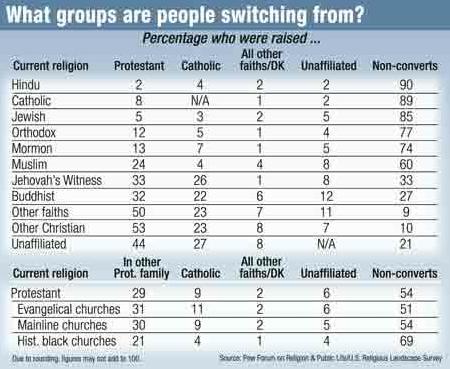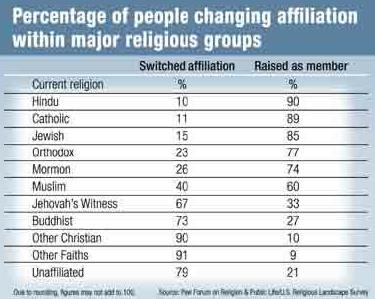Issue Date: March 7, 2008
Study finds fluid religions affiliation
 By ADELLE M. BANKS
Religion News Service
If you’re Buddhist in the United States, you’re most likely a
white convert who lives in the American West.
If you’re a Jehovah’s Witness, you’re likely to be a
white Southerner, but almost half of your fellow believers are either
African-American or Hispanic.
If you’re a Midwesterner, you’re living in the region that
best reflects the religious diversity of America.
A new study of more than 35,000 adult Americans by the Pew Forum on
Religion & Public Life captures the depth and breadth of religious America
-- 78.4 percent Christian, 4.7 percent members of other faiths and 16.1 percent
unaffiliated.
The U.S. Religious Landscape Survey, released Feb. 25, estimates the
religious makeup of the country’s 225 million adults in groups as large as
evangelical Protestants (26.3 percent) and as small as Unitarians (0.3
percent).
Believing but not belonging
Why are young people dropping out of organized religion? Why do a third of cradle Catholics leave the church? Does marriage affect one's religion? Researchers from the Pew Forum on Religion and Public Life examine these questions. Listen.
The study also paints a picture of people who often move from one faith
to another, as well as the religious landscape of various parts of the country.
Pew researcher John Green called the Midwest a “microcosm of American
religion” and said it closely matches the overall religious profile of the
U.S. population’s largest religious groups:
- Evangelical Protestant: 26 percent
- Mainline Protestant: 22 percent
- Catholic: 24 percent
 “In religious terms, the Midwest really ... does reflect, of all
the regions, the great diversity, at least in terms of affiliation,” said
Green, a senior fellow at the Pew Forum and an expert on religion and politics
at the University of Akron. “In religious terms, the Midwest really ... does reflect, of all
the regions, the great diversity, at least in terms of affiliation,” said
Green, a senior fellow at the Pew Forum and an expert on religion and politics
at the University of Akron.
Stephen Prothero, who chairs the religion department at Boston
University, said that description fits, given the predominantly Catholic
Northeast, mostly Baptist South and a Western region known for Buddhists,
Hindus and people with no religious affiliation.
Other key findings of the study include:
- Of the 16.1 percent of Americans who are not affiliated with any
faith, just 4 percent describe themselves as atheist or agnostic. The remaining
12 percent are almost equally divided between the “secular
unaffiliated,” who say religion is not important in their lives and the
“religious unaffiliated,” who say religion is at least somewhat
important.
- Catholics are the religious group with the greatest loss of
adherents, with former Catholics making up about 10 percent of the U.S.
population. Hindus, on the other hand, are best at retaining their faith; eight
in 10 Hindus who were born into the faith remain connected to it.
- More than a quarter of Americans -- 28 percent -- have left the faith
of their childhoods for another -- or no faith at all. Including changes from
one form of Protestantism to another, 44 percent of Americans have changed
their affiliation or dropped their connection to a faith. Jehovah’s
Witnesses and Buddhists are among the faiths with the lowest retention rates of
childhood members.
- The nation’s Protestants make up just 51 percent of the U.S.
population, meaning that segment of Christianity is close to becoming a
religious minority. Young people are helping fuel that trend: While 62 percent
of Americans 70 and older are Protestant, only 43 percent of Americans ages
18-29 are.
- Barry Kosmin, a sociologist of religion at Trinity College in
Connecticut, said he first detected a drop in Protestant identification in the
1990s. “ ‘Christian’ has kind of replaced ‘Protestant’
as a term for most Americans,” he said. “If you ask most students
‘What is a Protestant?’ they don’t even know the
term.”
- Muslims are the most racially diverse faith group, including 37
percent who are white, 24 percent who are black, and 20 percent Asian.
- More than a third of married Americans -- 37 percent -- are married
to someone with a different religious affiliation, including a different
Protestant faith. Hindus and Mormons are most likely to be married to someone
of the same religion, while majorities of Buddhists and the
“unaffiliated” have married someone of a different religion.
- Researchers found that Jews outnumber Muslims, with Jews comprising
1.7 percent of the adult population and Muslims comprising 0.6 percent.
The Pew survey results are based on more than 35,000 telephone
interviews, some of which were done in Spanish, between May and August
2007.
The margin of error for distinct religious groups varies widely
depending on sample size. For the 9,472 evangelical Protestants surveyed, it
was plus or minus 1.5 percentage points, but for the 411 Buddhist respondents,
it was plus or minus 6.5 percentage points.
On the Web
You can read more reports on this landmark survey
by visiting the Daily News Feed on
NCRcafe.org.
You can listen to an interview with the principal authors of the report
in the Podcast section of
NCRcafe.org.
| “We’re a society that ... [has] begun to embrace not just
religious diversity but appreciate religious diversity.”
-- Mark Chaves of Duke University Divinity School
“Men are significantly more likely than women to claim no religious
affiliation.”
-- From the survey report
“Men just don’t buy into religious instruction as little boys
as much as women do as girls. It carries over throughout life.”
-- Robert Altemeyer, professor of psychology at the University of
Manitoba
“Black Americans are the most likely to report a formal religious
affiliation. ... Asians are the most likely to be unaffiliated.”
-- From the survey report |
National Catholic Reporter, March 7,
2008 |


